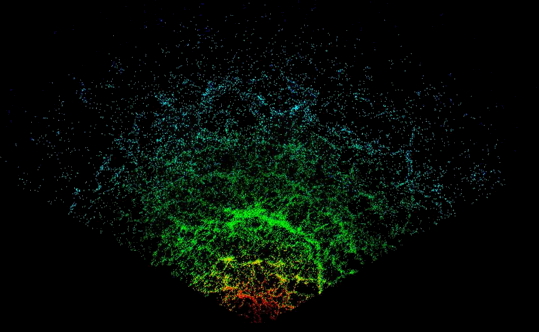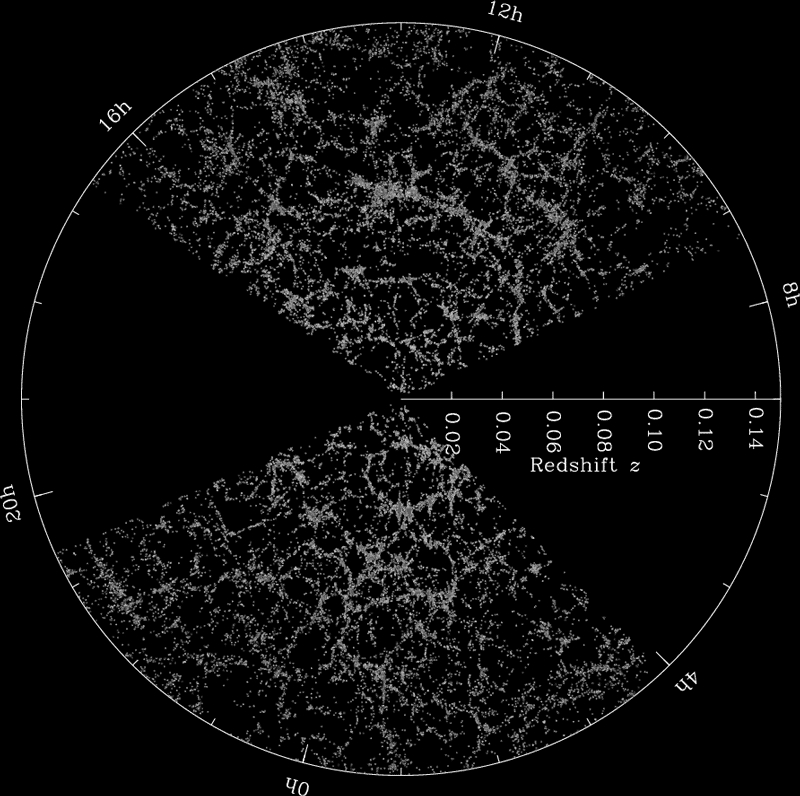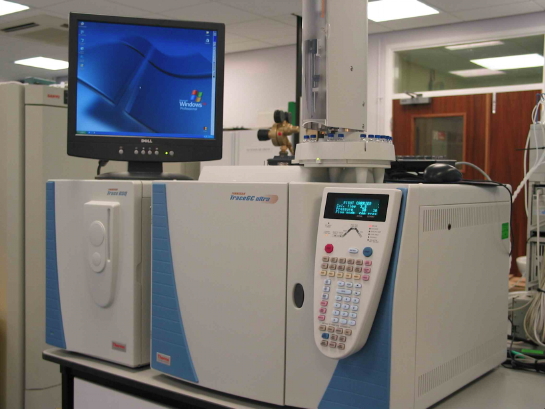 * Scientists, By Faith, Reject that the Universe has a Center: [Updated June 2020] Real Science Radio's Bob Enyart and Fred Williams document the admission by leading Big Bang scientists that there is no known scientific evidence that confirms the widely accepted belief by cosmologists like Stephen Hawking and physicists like Lawrence Krauss that the universe has no center. Therefore we here document leading scientists who admit that the Copernican Principle (that we are not in the center of the universe), and its more generalized version, the Cosmological Principle, that the universe is homogeneous (the same everywhere) AND isotropic (the same in every direction). If those two claims had not been falsified by the greatest scientific observations ever made (see the first bullet at rsr.org/bbp), they would combine in support of the Copernican Principle, that the universe has no center. That Copernican claim though, of course, is not an observational but philosophical. All this current secular dogma amounts not to a scientific conclusion but to a presuppositional belief. Whether or not the universe has a center is not essential to the Christian faith, but is passionate dogma to most atheistic scientists. So below we:
* Scientists, By Faith, Reject that the Universe has a Center: [Updated June 2020] Real Science Radio's Bob Enyart and Fred Williams document the admission by leading Big Bang scientists that there is no known scientific evidence that confirms the widely accepted belief by cosmologists like Stephen Hawking and physicists like Lawrence Krauss that the universe has no center. Therefore we here document leading scientists who admit that the Copernican Principle (that we are not in the center of the universe), and its more generalized version, the Cosmological Principle, that the universe is homogeneous (the same everywhere) AND isotropic (the same in every direction). If those two claims had not been falsified by the greatest scientific observations ever made (see the first bullet at rsr.org/bbp), they would combine in support of the Copernican Principle, that the universe has no center. That Copernican claim though, of course, is not an observational but philosophical. All this current secular dogma amounts not to a scientific conclusion but to a presuppositional belief. Whether or not the universe has a center is not essential to the Christian faith, but is passionate dogma to most atheistic scientists. So below we:
- document leading scientists admitting that the Cosmological Principle is a philosophy
- give examples of atheists who hype the claim that the universe has no center
- present evidence that the universe may have a center from our catalog of papers on redshift
- show that it is an atheistic fabrication to claim that the Church ever taught that the Earth was flat
- point out that the president of the actual "Flat Earth Society" is not a creationist but an evolutionist
- remind everyone that geocentrism came not from the Bible but from the pagan philosophers Plato and Aristotle, and we
- observe that although the Earth is almost at the center of the concentric spheres of galaxies, it is just far enough off center to falsify the claim that the observational data is some kind of isotropic mirage.
* Hawking, Feynman, Tipler, Hubble, etc. Admit Cosmological Principle is Philosophy: The Standard Model cosmological claim that the universe has no center is based on philosophy and is not confirmed by observation. Consider:
- George Ellis: Scientific American profiled the Stephen Hawking co-author cosmologist Ellis quoting him stating [June 28, 2020 Update: SciAm put this behind a paywall or removed it. If you find a working alternative link, please send it along to Bob@rsr.org. Thanks!] that:
“People need to be aware that there is a range of models that could explain the observations... For instance, I can construct you a spherically symmetrical universe with Earth at its center, and you cannot disprove it based on observations... You can only exclude it on philosophical grounds... What I want to bring into the open is the fact that we are using philosophical criteria in choosing our models. A lot of cosmology tries to hide that.”
- Stephen Hawking: Likewise, Hawking wrote elsewhere, in The Large Scale Structure of Space-Time that scientists, "are not able to make cosmological models without some admixture of ideology." And in 2005 from The Theory of Everything, pp. 22-23:
"... it might seem that if we observe all other galaxies to be moving away from us, then we must be at the center of the universe. There is, however, an alternate explanation: the universe might look the same in every direction as seen from any other galaxy, too. This, as we have seen, was Friedmann's second assumption. We have no SCIENTIFIC evidence for, or against this assumption. We believe it only on grounds of modesty: it would be most remarkable [i.e. unexpected to materialists] if the universe looked the same in every direction around us, but not around other points in the universe ..."
- Philip Gibbs: This former research fellow from Edinburg University wrote in a collection of articles posted at the University of California, Riverside, right on point, that: "Despite the discovery of a great deal of structure in the distribution of the galaxies, most cosmologists still hold to the cosmological principle either for philosophical reasons or because it is a useful working hypothesis..."
- Marie-Noelle Celerier: Even regarding supernovae data explicitly, French astrophysicist Celerier wrote that, "ruling out the Cosmological Principle" is a valid interpretation of the data.
- Richard Feynman: As a Nobel prize-winning physicist and author of QED on quantum electrodynamics (of one of Bob's favorite books), Feynman lectured, "I suspect that the assumption of uniformity of the universe reflects a prejudice... It would be embarrassing to find, after stating that we live in an ordinary planet about an ordinary star in an ordinary galaxy, that our place in the universe is extraordinary … To avoid embarrassment we cling to the hypothesis of uniformity." Yet thirty years after Feynman's warning, the journal Nature was still publishing (and to today) quotes like this: "Darwin showed that, in terms of origin, we are not privileged above other species. Our position around an ordinary star in an ordinary galaxy in and ordinary supercluster continues to look less and less special."
- John Barrow and Frank Tipler: These famed cosmologists begin their standard text, The Anthropic Cosmological Principle, referring to that doctrine, which they themselves defend, as a "twentieth-century dogma" [emphasis added]. And they immediately admit that it is challenged by the apparent life-supporting fine tuning of the universe, and philosophy is an admitted recurrent element of the book's first few chapters, with the brief forward, written by theoretical physicist John Wheeler, twice mentioning the philosopher, and the philosophical considerations of the book.
- Edwin Hubble: As patron saint of atheist cosmologists, in his 1936 classic, The Observational Approach to Cosmology, Hubble admits that it is philosophy and not observational science that leads him to believe that the universe has no center. Summing up his pages 50-59, creationist astrophysicist John Hartnett writes: "[W]hat Edwin Hubble concluded [was that] his observations of the galaxies’ redshifts indicated to him that we are at the centre of a symmetric matter distribution. But Hubble rejected his own conclusion—that we are in a very special place—on philosophical grounds." For example:
"Such a condition would imply that we occupy a unique position in the universe, analogous, in a sense, to the ancient conception of a central earth. The hypothesis cannot be disproved but it is unwelcome..." Regarding the possibility that "the observer [is] in a unique position [this] unwelcome supposition of a favoured location must be avoided at all costs. Therefore, we accept the uniform distribution..." -Edwin Hubble, author of, ehem, The Observational Approach to Cosmology ;)
- Willem de Sitter: In 1931, this early advocate of the expanding universe said to the British Association with Jeans, Eddington, Lemaître, et al, present: "In making a theory of the universe we must, however, adopt some extrapolation, and we can choose it so as to suit our philosophical taste… that our neighbourhood is just an ordinary point, or small area, in the universe, not differing from any other small area in any essential property." Further, de Sitter said that the expanding universe theory "shows the observed radial motions of the spiral nebulae to be in accordance with… the field equations of the general theory of relativity… I must lay stress on the fact that, in using the words 'universe,' 'radius,' 'expansion,' etc., we are really speaking metaphorically, putting an interpretation on the equation of the theory, which is by no means imperative. There occurs in the equation a certain quantity, which may be either positive, negative, or zero, and which is interpreted as the reciprocal of the square of the radius of the curvature. But both this interpretation, and the assumption tacitly made that it is positive (thus making the three-dimensional universe closed) are entirely gratuitous, and not demanded by the theory."
- Georges Lemaître: Also in 1931, to the British Association, the father of the big bang theory said: "I propose to give some answer to… Sir James Jeans… 'Is the universe expanding at about the rate indicated by the spectra of the nebulae,' … The expansion of the universe is a matter of astronomical facts interpreted [somewhat arbitrarily, as de Sitter pointed out] by the theory of relativity, with the help of assumptions as to the homogeneity of space…"
 - Werner Heisenberg: Let's look at the larger picture with one of the world's fathers of the smallest picture, that is, of quantum mechanics. Making an observation about much more than mere cosmology, the physicist author of the Heisenberg Principle, also wrote, "All scientific work is, of course, based consciously or subconsciously on some philosophical attitude... Most scientists are willing to accept new empirical data and to recognise new results, provided they fit into their philosophical framework. But in the course of scientific progress it can happen that a new range of empirical data can be completely understood only when the enormous effort is made to enlarge this framework..." (Born and Einstein, 1971, p. x). Such empirical data may be staring in the face of the society of philosophy known as modern astronomy. Without accepting the data (see below) pointing to a center of the universe, the Uncertainty Principle if applied here ;) means that even if cosmologists determine the momentum of the expansion of the universe, they will know neither where it is nor from whence it came.
- Werner Heisenberg: Let's look at the larger picture with one of the world's fathers of the smallest picture, that is, of quantum mechanics. Making an observation about much more than mere cosmology, the physicist author of the Heisenberg Principle, also wrote, "All scientific work is, of course, based consciously or subconsciously on some philosophical attitude... Most scientists are willing to accept new empirical data and to recognise new results, provided they fit into their philosophical framework. But in the course of scientific progress it can happen that a new range of empirical data can be completely understood only when the enormous effort is made to enlarge this framework..." (Born and Einstein, 1971, p. x). Such empirical data may be staring in the face of the society of philosophy known as modern astronomy. Without accepting the data (see below) pointing to a center of the universe, the Uncertainty Principle if applied here ;) means that even if cosmologists determine the momentum of the expansion of the universe, they will know neither where it is nor from whence it came.
* An Atheist and an Evolutionist who Present Faith as Science: Theoretical physicist (emphasis on the theoretical) Lawrence Krauss and popular evolutionist Aron Ra, both of whom have appeared on Real Science Radio, claim that there is no center of the universe, and as follows, that our Milky Way galaxy is not at or near the center.
- For example Lawrence Krauss said on RSR that he doesn't believe anything. Krauss fancifully claims that he holds no beliefs, as though he were bathed in facts, pure as the driven snow. But what's worse than those who make the naive claim that they hold no beliefs but only operate based on repeatable, observational facts, is that many scientists conduct their life's work while denying the existence of their own belief system yet allowing that very philosophy to control their conclusions and even the scope of investigation that they permit.
- And AronRa asserted on RSR that, "There is NO CENTER to the universe." Despite our effort in debates with Ra on air and in writing, neither Aron Ra (nor apparently his fellow atheists at the UK's League of Reason) have admitted that it is not based on evidence, but by faith. Countless atheists and evolutionists believe in the Cosmological Principle. In Aron Ra's case, he should be willing to admit that he thereby violates his own claimed standard, as he says, that:
…if you believe in truth at all, then you should make sure that the things that you say actually are true [something he hasn't done regarding the universe having no center]. That they are defensibly accurate, and academically correct. And if they are not correct, you should correct them. You wouldn't claim to know anything that you couldn't prove that you knew [like that the universe lacks a center]." hear it
Ra says that Enyart wrongly claimed that PNAS published an alternative big bang model. Enyart acknowledged that he did not himself know whether or not the universe had a center, but added that the Proceedings of the National Academy of Sciences in 2003 published a paper proposing an alternative cosmology, of a bounded universe centered on our Milky Way galaxy. Aron dismissed this on air, and in our later written debate wrote:
"Bob claimed an alternative model to Big Bang cosmology -which does not exist…" -Aron Ra
Standard BB cosmology claims an unbounded, homogeneous (the same everywhere) universe that therefore lacks a center. The alternative BB model I referenced was published in 2003 in PNAS. Smoller and Temple describe their proposal writing, "by incorporating a shock wave at the leading edge of the expansion of the galaxies… [which would be] bounding a finite total mass", that yields, "a cosmological model… of an asymptotically flat Schwarzschild spacetime." Physics professor John Hartnett explains that Smoller thereby "implies that the earth or at least the Galaxy is in fact close to the physical center of the Universe." As Smoller and Temple themselves admit, in their paper, "the Copernican Principle is violated in the sense that the earth then has a special position relative to the shock wave.
"Bob claimed an alternative model to Big Bang cosmology -which does not exist, and he said it was concordant with the creationists' model of the universe -which also does not exist." -Aron Ra
See the two creation models I briefly describe and link to at rsr.org/starlight-and-time#time-dilation proposed by two physicists, one a professor in Australia who has received a prestigious IEEE award, and the other an alumnus of Sandia National Labs where he received awards, including an Award for Excellence for contributions to light ion–fusion target theory. RSR doesn't promote these young-earth models, but we've said on air, they are consistent with that 2003 PNAS paper including in that they propose a bounded universe centered on our solar system. Yet instead of engaging on the substance Ra and the atheists at League of Reason prefer to mock.

* Observational Evidence Pointing to a Center: The most extensive observational evidence ever collected in the history of science is being subjected to intense philosophical bias because of the "embarrassment" mentioned by Feynman above and the emotional anti-creationism of atheistic cosmologists. The most apparent interpretation of the redshift data averaged from about a hundred billion stars in each of hundreds of thousands of galaxies suggests that these galaxies may be positioned at preferred distances from the center of the universe in concentric galactic spheres. As bolstered by the statements above from leading secular physicists and astrophysicists like Hawking, Ellis, Feynman, etc., that the cosmological principle is philosophical rather than observational, consider these secular and creationist astrophysicist and cosmologists who have documented the quantized redshift suggesting that galaxies may exist in preferred distances and concentric shells out from the center of the universe:
 * Liquefaction Formed Continent-wide Flat-Gap Strata: On the world's continents there are beautifully uniform and "flat-gap" boundaries, as though formed by a putty knife, between sediments over hundreds of thousands of square miles around the globe. To a significant degree, these flat boundaries between strata are the result of the sorting after burial of minerals (along with animal fossils and vegetation in coal seams, etc.). Thus liquefaction helps to explain both the geologic column and the formation of highly purified (limestone, diatomaceous, etc.) deposits, through its potential for even continent-wide sorting of minerals into finely differentiated layers.
* Liquefaction Formed Continent-wide Flat-Gap Strata: On the world's continents there are beautifully uniform and "flat-gap" boundaries, as though formed by a putty knife, between sediments over hundreds of thousands of square miles around the globe. To a significant degree, these flat boundaries between strata are the result of the sorting after burial of minerals (along with animal fossils and vegetation in coal seams, etc.). Thus liquefaction helps to explain both the geologic column and the formation of highly purified (limestone, diatomaceous, etc.) deposits, through its potential for even continent-wide sorting of minerals into finely differentiated layers.
 * What is Liquefaction: See the formerly buried concrete structure on the right, which floated up during a Japan earthquake. Walt Brown quotes geologist Arthur Strahler, from book, Physical Geology, "These water-saturated deposits often experience a change in property known as liquefaction when shaken by an earthquake. The material loses strength to the degree that it becomes a highly fluid mud..." Kevin reports that after a recent Washington earthquake, geologists asked residents to report any sightings of mud flowing out of the ground so that they can better understand the dynamics of liquefaction.
* What is Liquefaction: See the formerly buried concrete structure on the right, which floated up during a Japan earthquake. Walt Brown quotes geologist Arthur Strahler, from book, Physical Geology, "These water-saturated deposits often experience a change in property known as liquefaction when shaken by an earthquake. The material loses strength to the degree that it becomes a highly fluid mud..." Kevin reports that after a recent Washington earthquake, geologists asked residents to report any sightings of mud flowing out of the ground so that they can better understand the dynamics of liquefaction.



















 * Feature Creep:
* Feature Creep: